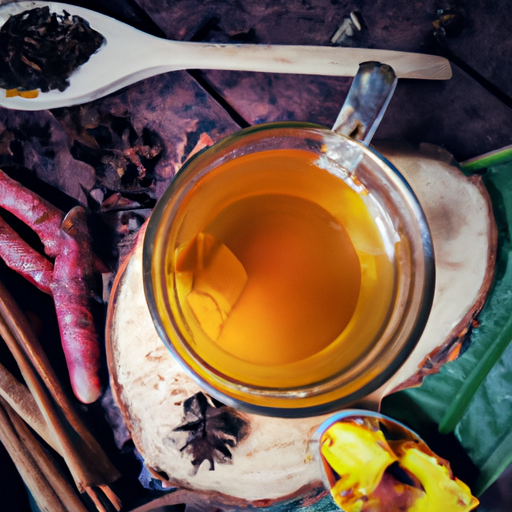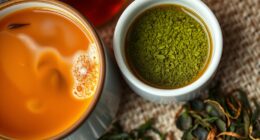As an individual living with arthritis, I have personal experience with the challenges of dealing with the pain and swelling associated with this ailment.
While there are certainly medications and treatments available, I’ve also found that incorporating natural remedies into my routine has been incredibly helpful.
One of my favorite remedies is turmeric tea.
Turmeric is a spice that has been used in traditional medicine for centuries due to its anti-inflammatory properties.
In recent years, scientific studies have confirmed these benefits, making turmeric a popular supplement for those with arthritis and other inflammatory conditions.
By learning how to make turmeric tea at home, you can easily incorporate this powerful spice into your daily routine and potentially experience some relief from your symptoms.
Key Takeaways
- Turmeric has anti-inflammatory properties that can reduce inflammation throughout the body, making it beneficial for arthritis and other inflammatory conditions.
- When making turmeric tea, it’s important to choose high-quality, organic, non-GMO turmeric powder free of additives and fillers, and to measure ingredients accurately.
- Additional ingredients like black pepper, ginger, and honey can be added for flavor and health benefits, and the tea should be simmered over low heat to meld flavors and prevent bitterness.
- It’s important to consume turmeric in moderation and consult with a healthcare provider before starting any new supplements or making significant changes to the diet, as excessive consumption may lead to gastrointestinal issues and liver damage, and may interact with medications like blood thinners, diabetes medications, and stomach acid reducers.
Understanding Arthritis and Its Symptoms
If you’re experiencing joint pain and stiffness, you might have arthritis – but don’t worry, there are plenty of natural remedies to alleviate your symptoms.
Arthritis is a condition characterized by inflammation in one or more joints in the body. It can be caused by a variety of factors such as age, genetics, injury, or infection.
There are over 100 types of arthritis, but the most common forms include osteoarthritis and rheumatoid arthritis. Osteoarthritis occurs when the cartilage that cushions the joints wears down over time, leading to bone-on-bone contact and pain. Rheumatoid arthritis is an autoimmune disorder where the immune system attacks the joints causing inflammation and pain.
While there is no cure for arthritis, there are many natural remedies that can help alleviate symptoms. These include exercise, maintaining a healthy weight, using heat or cold therapy on affected areas, and incorporating anti-inflammatory foods like turmeric into your diet.
Speaking of turmeric… Choosing high-quality turmeric powder is key to making effective turmeric tea for arthritis relief.
Choosing High-Quality Turmeric Powder
Before you start brewing a cup of the golden elixir, make sure you’ve sourced high-quality turmeric powder that’ll provide optimal benefits for your joints.
Not all turmeric powders are created equal, so it’s important to do some research and choose a reputable supplier. Look for turmeric powder that’s organic, non-GMO, and free of additives and fillers. One way to ensure you’re getting high-quality turmeric powder is to look for brands that’ve been certified by third-party organizations such as the USDA or NSF International. These certifications guarantee that the turmeric’s been grown without harmful chemicals and meets strict quality standards. You can also read reviews from other customers to get an idea of their experiences with different brands.
Once you’ve chosen your high-quality turmeric powder, it’s time to gather the rest of your supplies and ingredients. This includes water, honey or another sweetener (optional), black pepper (to increase absorption), and any additional spices or herbs you’d like to add for flavor.
Let’s dive into the next steps in making delicious and beneficial turmeric tea for arthritis relief!
Gathering Supplies and Ingredients
Now that you’ve sourced high-quality turmeric powder, it’s time to gather the rest of your supplies and ingredients for brewing a cup of delicious and beneficial golden elixir. When it comes to sourcing turmeric, it’s important to choose fresh roots or powder from a reputable supplier. Additionally, be sure to read labels carefully as some powders may contain additives or fillers that compromise their quality.
In addition to turmeric powder or fresh roots, you’ll need a few other key ingredients to make your arthritis-fighting tea. These include black pepper, which helps increase the bioavailability of curcumin (the active ingredient in turmeric) in the body. Ginger is another great addition as it has anti-inflammatory properties similar to those found in turmeric. Finally, honey can be added for sweetness and additional health benefits beyond arthritis.
To help visualize what you’ll need for this recipe, here’s a table outlining the supplies and ingredients:
| Supplies | Ingredients |
|---|---|
| Teapot or saucepan with lid | 1 tsp turmeric powder or 1 inch fresh turmeric root |
| Strainer | ½ tsp freshly ground black pepper |
| Mug | 1 inch fresh ginger root |
| Spoon | Honey (to taste) |
With these essential supplies and ingredients on hand, you’re ready to move onto the basic turmeric tea recipe. This simple yet effective recipe will give you all the tools needed to brew an aromatic cup of anti-inflammatory goodness that will have your joints feeling better in no time!
Basic Turmeric Tea Recipe
So now that I’ve gathered all the necessary ingredients, it’s time to make some turmeric tea for my arthritis.
The first step is measuring out the ingredients – 1 teaspoon of ground turmeric and a pinch of black pepper.
Next, I’ll add these to 2 cups of water in a small saucepan and bring it to a simmer for about 10 minutes.
Once the tea has simmered, I’ll strain it and serve with honey or lemon juice if desired.
Measuring Ingredients
Gettin’ the right measurements of turmeric, ginger, and honey is crucial to makin’ the perfect cup of arthritis-fightin’ tea.
Here are some measurin’ techniques that you can use for your recipe:
-
Use a kitchen scale to weigh your ingredients accurately. This will ensure that you get the right amount of each ingredient every time.
-
For those who don’t have a kitchen scale, measuring spoons can be used as an alternative. A tablespoon corresponds to approximately 6 grams of turmeric powder.
-
If you prefer a stronger or weaker flavor in your tea, adjust the measurements accordingly.
Once you’ve measured out all your ingredients correctly, it’s time to simmer the tea.
Simmering the Tea
To get that perfect cup of anti-inflammatory turmeric tea, you’ll want to let your ingredients simmer together on the stove. The key to a successful simmer is to use low heat and let the mixture cook slowly over time. This will allow the flavors of all the ingredients to meld together and infuse into the water.
When simmering your turmeric tea, it’s important not to let it boil. Boiling can degrade some of the beneficial compounds in the turmeric and other herbs, lowering their health benefits. Additionally, boiling can cause bitter flavors to develop in your tea, which may not be desirable for everyone. So keep an eye on your pot and adjust the heat as needed to maintain a gentle simmer.
Now that our tea has been allowed ample time to steep, we’re ready for our next step: straining and serving.
Straining and Serving
Once your turmeric tea has simmered to perfection, it’s time for you to strain the mixture and pour it into your favorite mug for a soothing and flavorful beverage that will leave you feeling refreshed and rejuvenated. To strain the tea, simply place a fine-mesh strainer over your mug and slowly pour the liquid through it. This will help remove any small bits of ginger or other ingredients that may have made their way into the mixture.
As you sip on your freshly brewed turmeric tea, take note of the many health benefits beyond just easing arthritis pain. Turmeric is known to have anti-inflammatory properties which can aid in reducing inflammation throughout the body. Additionally, this spice has been shown to boost brain function and lower risk factors for heart disease. With all these added benefits, incorporating turmeric tea into your daily routine is an easy way to promote overall wellness. Moving forward, let’s explore how we can customize our turmeric tea for an even more personalized experience.
Customizing Your Turmeric Tea
If you’re feeling adventurous, try adding a pinch of black pepper to your turmeric tea for an extra kick and enhanced absorption. Black pepper contains piperine, which has been shown to increase the bioavailability of curcumin, the active ingredient in turmeric. This means that when consumed together, turmeric and black pepper can have even more powerful anti-inflammatory effects.
Here are four other ways to customize your turmeric tea:
- Add honey or maple syrup for sweetness.
- Use coconut milk instead of regular milk for a creamy texture and added health benefits.
- Experiment with different spices like cinnamon or ginger for added flavor.
- Try steeping other herbs like chamomile or lavender along with the turmeric for a relaxing bedtime drink.
Customizing your turmeric tea is not only fun but also allows you to tailor it to your personal taste preferences and health goals. Now that you know how to add some extra flavor and nutrients to your cup of turmeric tea, let’s move on to some tips for making the perfect cup every time.
Tips for Making the Perfect Cup of Turmeric Tea
When making turmeric tea, I always adjust the recipe to my taste. It’s important to experiment with different amounts of ginger, honey, and lemon juice until you find the perfect blend for your palate.
Plus, it’s easy to store leftover tea in the fridge for a refreshing iced version later on. Just be sure to strain out any solids before refrigerating!
Adjusting the Recipe to Your Taste
To truly enjoy and benefit from turmeric tea, you’ll want to adjust the recipe to your personal taste preferences. If you prefer your tea sweeter, you can add honey or maple syrup instead of sugar. You can also adjust the amount of turmeric and other spices in the recipe based on how strong or mild you prefer the flavor.
Adding other spices like ginger, cinnamon, or cardamom can also enhance the taste of your turmeric tea. These spices not only add more depth to the flavor profile but also offer their own health benefits. Ginger is known for its anti-inflammatory properties while cinnamon helps regulate blood sugar levels. Experiment with different spice combinations until you find what works best for you and your taste buds.
Now that we’ve talked about adjusting the recipe, let’s move on to storing leftover tea without it losing its potency.
Storing Leftover Tea
Once you’ve brewed your turmeric tea, storing the leftovers properly is important to maintain its potency and flavor, much like how a bee carefully stores pollen in its hive. There are several preservation techniques you can use to keep your leftover turmeric tea fresh for longer. One option is to store it in an airtight container in the refrigerator, where it will stay fresh for up to three days. You can also freeze leftover turmeric tea into ice cubes and add them to smoothies or other drinks for an extra boost of anti-inflammatory properties.
Another alternative use for leftover turmeric tea is using it as a base for soups or stews. The earthy flavor of turmeric adds depth and complexity to savory dishes while also providing health benefits. Experiment with adding it to chicken noodle soup or lentil stew for a delicious twist on traditional recipes. With these preservation techniques and alternative uses, you can get the most out of your turmeric tea even after the initial brew.
Moving forward, let’s explore the potential benefits of drinking turmeric tea for arthritis.
Potential Benefits of Drinking Turmeric Tea for Arthritis
Drinking turmeric tea regularly can potentially alleviate arthritis symptoms due to its anti-inflammatory properties. If you’re looking for a natural way to manage your arthritis, turmeric tea is worth considering.
Here are four potential benefits of drinking turmeric tea for arthritis relief:
-
Reduced inflammation: Turmeric contains curcumin, which has been shown to have anti-inflammatory effects. By reducing inflammation in the body, turmeric tea may help relieve joint pain and stiffness.
-
Improved joint mobility: Arthritis can make it difficult to move your joints freely. Drinking turmeric tea may improve joint mobility by reducing inflammation and promoting healthy circulation.
-
Enhanced immune function: Chronic inflammation can weaken the immune system over time, making it harder for your body to fight off infections and illnesses. By reducing inflammation, turmeric tea may help boost immune function and overall health.
-
Antioxidant protection: Turmeric is high in antioxidants, which help protect the body from damage caused by free radicals. This protection may be especially important for those with arthritis, as oxidative stress has been linked to disease progression.
Incorporating turmeric into your daily routine doesn’t have to be limited to just drinking tea – there are many other ways to enjoy this spice’s health benefits!
Other Ways to Incorporate Turmeric into Your Diet
If you’re a fan of Indian cuisine, you may already be incorporating turmeric into your diet through dishes like curry or dal. However, there are plenty of other ways to add this powerful spice to your meals.
One simple way is by making turmeric tea. You can mix ground turmeric with hot water and honey for a soothing and anti-inflammatory drink that can help alleviate arthritis symptoms.
Another option is to use turmeric in smoothies or juices. Try blending fresh turmeric root with fruits like pineapple or mango for a refreshing and healthy drink. You can also sprinkle ground turmeric on roasted vegetables or add it to soups and stews for an extra boost of flavor and health benefits.
There are countless recipes out there that incorporate turmeric, so don’t be afraid to get creative in the kitchen. Just remember that while turmeric has numerous health benefits, it’s important to consume it in moderation and talk to your doctor if you’re considering taking supplements or using large amounts of the spice in your cooking.
Moving forward, it’s important to consider precautions and side effects when consuming too much of any ingredient – even one as seemingly harmless as turmeric!
Precautions and Side Effects
Before I dive into the potential precautions and side effects of turmeric, I want to emphasize that it’s always important to consult with your healthcare provider before starting any new supplements or making significant changes to your diet.
One key consideration when taking turmeric is possible interactions with medications, especially blood thinners or anti-inflammatory drugs.
Additionally, while turmeric has many potential health benefits, excessive consumption can lead to gastrointestinal issues and even liver damage.
Possible Interactions with Medications
Be aware that turmeric can interact with certain medications, so it’s important to check with your doctor before adding it to your routine. Some medications that may interact with turmeric include blood thinners, diabetes medications, and stomach acid reducers. Taking turmeric alongside these medications may increase their effects or cause adverse reactions.
Blood thinners like warfarin and aspirin should be used cautiously when taking turmeric as it may increase the risk of bleeding. Diabetes medications like insulin and metformin may have their effects increased when taken together with turmeric. Stomach acid reducers like omeprazole and ranitidine may also have their effects increased by turmeric, leading to potential side effects.
It’s crucial to inform your healthcare provider if you plan on incorporating turmeric into your diet or supplement regimen in order to avoid any unfavorable interactions. It’s important to take precautions when using natural remedies like turmeric, especially if you are taking other medications for a health condition.
In the next section, we will discuss avoiding excessive consumption of turmeric in order to maximize its benefits while minimizing any risks.
Avoiding Excessive Consumption of Turmeric
While turmeric is known to be beneficial for arthritis, it’s important to be mindful of its potential interactions with medications. However, even if you’re not taking any medication, excessive consumption of turmeric can lead to adverse effects.
To enjoy the benefits of turmeric tea without overdoing it, it’s crucial to balance your intake and monitor your dosage. The recommended daily intake of turmeric is around 500-2000mg per day. Consuming more than this amount may result in gastrointestinal issues such as diarrhea and nausea, or even liver problems.
It’s also important to note that high doses of turmeric may interact with blood-thinning medications and increase the risk of bleeding.
While incorporating turmeric into your diet can be helpful for arthritis symptoms, it’s essential to be aware of how much you consume. Balancing your intake and monitoring your dosage can help you avoid any unwanted side effects and ensure that you’re getting the most out of this natural remedy.
Frequently Asked Questions
Can turmeric tea completely cure arthritis?
As an AI language model, I can’t provide medical advice or make claims about turmeric tea’s effectiveness in treating arthritis. However, it’s important to note that arthritis currently has no known cure and requires ongoing management. Some people may find relief from symptoms through alternative treatments, such as exercise, physical therapy, acupuncture, or dietary changes.
It’s always best to consult with a healthcare professional before trying any new treatments.
How often should I drink turmeric tea to see results for arthritis?
To answer the question of how often one should drink turmeric tea to see results for arthritis, it’s important to understand the benefits of consuming this beverage. Turmeric has anti-inflammatory and antioxidant properties that can help reduce inflammation and pain in the joints.
However, there’s no set frequency that guarantees relief from arthritis symptoms as it varies depending on factors such as age, weight, and severity of the condition. It’s recommended to consume turmeric tea 2-3 times a day for several weeks or until improvements are noticed.
Additionally, there are other alternative turmeric-based remedies for arthritis relief such as supplements or incorporating turmeric into meals. Consult with a healthcare professional before starting any new treatment plan.
Can I use fresh turmeric instead of turmeric powder for the tea?
I love using fresh turmeric in my cooking and teas. I find that the flavor is more vibrant and complex than turmeric powder.
Using fresh turmeric in your tea can also provide additional benefits. Fresh turmeric contains higher levels of curcumin, which is the active ingredient responsible for reducing inflammation in the body. In fact, one study showed that fresh turmeric had a higher anti-inflammatory effect than dried turmeric powder.
So if you have access to fresh turmeric, I highly recommend using it in your daily routine for its added health benefits.
Is it safe to drink turmeric tea if I am taking medication for arthritis?
As someone taking medication for arthritis, it’s important to be cautious when consuming turmeric tea.
While turmeric has anti-inflammatory properties and may help alleviate arthritis symptoms, it can also interact with certain medications and cause potential side effects.
Specifically, turmeric can increase the risk of bleeding when taken with blood-thinning drugs like warfarin or aspirin.
It’s always best to consult with a healthcare provider before adding any new supplements or foods into your diet that could potentially interact with your medication.
Can I add honey or other sweeteners to my turmeric tea for arthritis?
When it comes to managing arthritis symptoms, turmeric can be a great addition to your routine. You can definitely add honey or another sweetener to your turmeric tea for arthritis! Adding sweetness can make the drink more palatable and enjoyable to consume regularly. However, keep in mind that some sweeteners may have negative effects on inflammation levels in the body, so it’s best to stick with natural options like raw honey or maple syrup.
Additionally, while drinking turmeric tea is a great way to incorporate this anti-inflammatory spice into your diet, there are plenty of alternative uses for turmeric as well. Exploring different methods of using turmeric could help further alleviate arthritis symptoms.
Conclusion
In conclusion, if you’re looking for a natural and effective way to relieve your arthritis symptoms, then turmeric tea could be the answer. It’s easy to make and packed with powerful anti-inflammatory properties that can help reduce pain and swelling in your joints.
By incorporating turmeric tea into your daily routine, you may notice a significant improvement in your overall health and wellbeing. The benefits of this golden spice are truly remarkable, from reducing inflammation to boosting immunity.
So why not give turmeric tea a try today? With just a few simple ingredients and some basic kitchen supplies, you can create a delicious and healthy beverage that will leave you feeling refreshed and rejuvenated. Go ahead and brew yourself a cup of this magical elixir – your body (and taste buds) will thank you!










